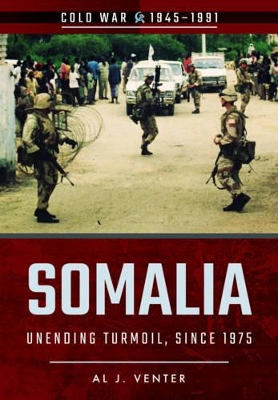Cold War 1945-1991
5 total works
When the world held its breath It is 25 years since the end of the Cold War, now a generation old. It began over 75 years ago, in 1944 long before the last shots of the Second World War had echoed across the wastelands of Eastern Europe with the brutal Greek Civil War. The battle lines are no longer drawn, but they linger on, unwittingly or not, in conflict zones such as Iraq, Somalia and Ukraine. In an era of mass-produced AK-47s and ICBMs, one such flashpoint was, and is, the Horn of Africa Few countries in Africa have had such powerful links with both the Soviet Union and United States each for several years at a stretch as Somalia. From a quiet Indian Ocean backwater that had once been an Italian colony, it remained aloof from the kind of power struggles that beset countries like Ghana, the Congo, Guinea, Algeria and others in the 1970s. Overnight, that all changed in 1969 when the army, led by Major General Siad Barre, grabbed power. His first move was to abrogate all security links he might have had with the West and to invite Moscow into his country as an ally.The Soviets moved quickly, establishing several air bases in the interior and stationing their ships in Somali ports.
Baledogle, a small airport north of Mogadishu, became a major air base from where Soviet military aircraft operated through much of the Indian Ocean. An impetuous man, Siad Barre believed his links with Moscow were secure enough to annex several neighbouring regions. But when he invaded Ethiopia s Ogaden Province Addis Ababa was then Washington s staunchest friend in Africa s Horn the Soviets had had enough. To the consternation of the West they abandoned Somalia and embraced Ethiopia, which resulted in the Russians giving full support in the Ogaden War to Addis Ababa and establishing the largest airlift of arms to an African country since the Six-Day War. For more than a decade thereafter conditions within Somalia deteriorated. Various tribal leaders established themselves as war lords , some with Soviet support, others getting succour from Western sources. It got so bad that in 1992 the United Nations eventually stepped in with Operation Restore Hope, a multi-national force created for conducting humanitarian operations in Somalia.The move was always controversial with many tribal leaders retaining either clandestine Soviet links or receiving aid from radical Arab forces that included al-Qaeda.
Though the United Nations and the African Union (AU) both maintain a strong presence in the country, hostilities and killings go on.
Baledogle, a small airport north of Mogadishu, became a major air base from where Soviet military aircraft operated through much of the Indian Ocean. An impetuous man, Siad Barre believed his links with Moscow were secure enough to annex several neighbouring regions. But when he invaded Ethiopia s Ogaden Province Addis Ababa was then Washington s staunchest friend in Africa s Horn the Soviets had had enough. To the consternation of the West they abandoned Somalia and embraced Ethiopia, which resulted in the Russians giving full support in the Ogaden War to Addis Ababa and establishing the largest airlift of arms to an African country since the Six-Day War. For more than a decade thereafter conditions within Somalia deteriorated. Various tribal leaders established themselves as war lords , some with Soviet support, others getting succour from Western sources. It got so bad that in 1992 the United Nations eventually stepped in with Operation Restore Hope, a multi-national force created for conducting humanitarian operations in Somalia.The move was always controversial with many tribal leaders retaining either clandestine Soviet links or receiving aid from radical Arab forces that included al-Qaeda.
Though the United Nations and the African Union (AU) both maintain a strong presence in the country, hostilities and killings go on.
When the world held its breath It is 25 years since the end of the Cold War, now a generation old. It began over 75 years ago, in 1944 long before the last shots of the Second World War had echoed across the wastelands of Eastern Europe with the brutal Greek Civil War. The battle lines are no longer drawn, but they linger on, unwittingly or not, in conflict zones such as Iraq, Somalia and Ukraine. In an era of mass-produced AK-47s and ICBMs, one such flashpoint was the Levant It is axiomatic that the recent history of much of the Eastern Mediterranean is linked to the creation of the state of Israel in May 1948, incontestably so. The country emerged from a series of conflicts and these have continued intermittently ever since, fuelled as much by Arab Israeli enmity, national pride and territorial aspirations as hostile neighbours. Syria, Jordan, Lebanon and Egypt and in the latter phases, Iran were all part of it. There were rich pickings in the regions for the two great powers of the Cold War as they aligned with one side or the other, the Soviets in full support of Arab interests and the Jewish State enjoying the support of Washington.That combination not only led to several Middle Eastern wars but, as we are able to observe in today s news reports, the knock-on effect continues in Lebanon, Jordan, Egypt and Syria especially.
For much of the period under review it was Lebanon that took the brunt of it, with resident Christian, Sunni, Shi ite as well as Israeli interests deploying multiple levels of force much of it clandestine to jockey for predominance. Throughout, land, sea and air forces were involved. Al Venter has devoted a good deal of his career towards covering these developments, from the early 1970s all the way through to the end of the Lebanese civil war in 1991. He has been to war with both Arab and Jew (he was with the IDF strike force headed by Ariel Sharon when he entered Beirut in 1982); spent time in Syria (visited that country s southern front adjacent to the Golan Heights); been on combat missions with the Israeli-backed South Lebanese Army in the Druze homeland adjacent to Mount Heron and has been embedded with the Lebanese Force Command along Beirut s Green Line, where many of his photos used in this publication were taken.Venter also spent a lot of time in South Lebanon with UNIFIL, the United Nations Interim Force in Lebanon, and was able to observe from up close the growing influence of the Pasdaran, Tehran s surrogate force in the region that eventually spawned Hezhollah.His last visit, in 1997, included contacts while hosted by Lebanese President General mile Lahoud with senior Iranian-supported Hezbollah elements in Beirut, one of few Western correspondents to have achieved this distinction.
For much of the period under review it was Lebanon that took the brunt of it, with resident Christian, Sunni, Shi ite as well as Israeli interests deploying multiple levels of force much of it clandestine to jockey for predominance. Throughout, land, sea and air forces were involved. Al Venter has devoted a good deal of his career towards covering these developments, from the early 1970s all the way through to the end of the Lebanese civil war in 1991. He has been to war with both Arab and Jew (he was with the IDF strike force headed by Ariel Sharon when he entered Beirut in 1982); spent time in Syria (visited that country s southern front adjacent to the Golan Heights); been on combat missions with the Israeli-backed South Lebanese Army in the Druze homeland adjacent to Mount Heron and has been embedded with the Lebanese Force Command along Beirut s Green Line, where many of his photos used in this publication were taken.Venter also spent a lot of time in South Lebanon with UNIFIL, the United Nations Interim Force in Lebanon, and was able to observe from up close the growing influence of the Pasdaran, Tehran s surrogate force in the region that eventually spawned Hezhollah.His last visit, in 1997, included contacts while hosted by Lebanese President General mile Lahoud with senior Iranian-supported Hezbollah elements in Beirut, one of few Western correspondents to have achieved this distinction.


